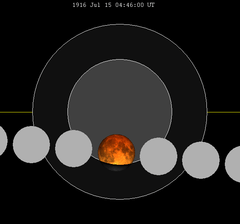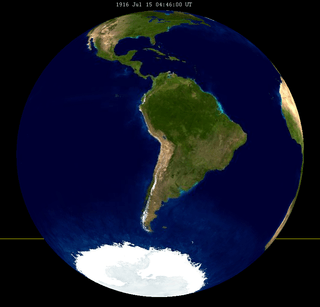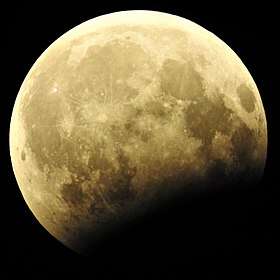July 1916 lunar eclipse
| Partial eclipse | |||||||||||||
 Chart of the eclipse; ecliptic north is up, hourly motion shown right to left | |||||||||||||
| Date | 15 July 1916 | ||||||||||||
|---|---|---|---|---|---|---|---|---|---|---|---|---|---|
| Gamma | -0.5956 | ||||||||||||
| Magnitude | 0.7994 | ||||||||||||
| Saros cycle | 118 (46 of 74) | ||||||||||||
| Catalog | LE1916Jul15P | ||||||||||||
| Duration | |||||||||||||
| Partiality | 172 minutes, 30 seconds | ||||||||||||
| Penumbral | 292 minutes, 24 seconds | ||||||||||||
| |||||||||||||
A partial lunar eclipse took place on 15 July 1916.
Observations
The Ross Sea party was a component of Sir Ernest Shackleton's Imperial Trans-Antarctic Expedition of 1914–17. Five men were stranded not far away from Cape Evans. There was sea ice between them and the relative safety of the hut on Cape Evans. On 8 May two of the men, Aeneas Mackintosh and Victor Hayward, decided to make an attempt to reach the hut. Soon after they set out a blizzard hit. When the weather cleared up, the remaining men tried to look for them, but realized that the ice was far too thin to cross, and that their friends had been lost. Now they knew that they should wait for a thicker ice and for the full moon to attempt the crossing. Having the full moon was essential, because during polar night the Moon is the only source of natural light other than the extremely dim light of the stars.
The weather did not cooperate during the full moon of June, but on 15 July, everything seemed to be just right: calm weather, thick ice, clear skies and a full Moon. The men started their journey in the morning. When the Moon rose, however, the men were surprised to find it was about to be eclipsed. Ernest Wild wrote later:
"I thought we were going to be left in darkness but a very little bit of the rim remained to light us..."
Although the eclipse continued for few hours, the men were fortunate because it was only a partial eclipse. They reached Cape Evans later on the same day.[1]
Visibility

See also
Notes
- ↑ Richard McElrea; David L. Harrowfield (2004). Polar castaways: the Ross Sea Party (1914–17) of Sir Ernest Shackleton. Canterbury University Press. p. 206. ISBN 9780773528253. Retrieved 2010-04-28.
References
- The Monthly Evening Sky Map, Volumes 9-11 PARTIAL LUNAR ECLIPSE OF JULY 14-15, 1916
- The Lost Men: The Harrowing Saga of Shackleton's Ross Sea Party, , By Kelly Tyler-Lewis
External links
- 1916 Jul 15 chart Eclipse Predictions by Fred Espenak, NASA/GSFC

